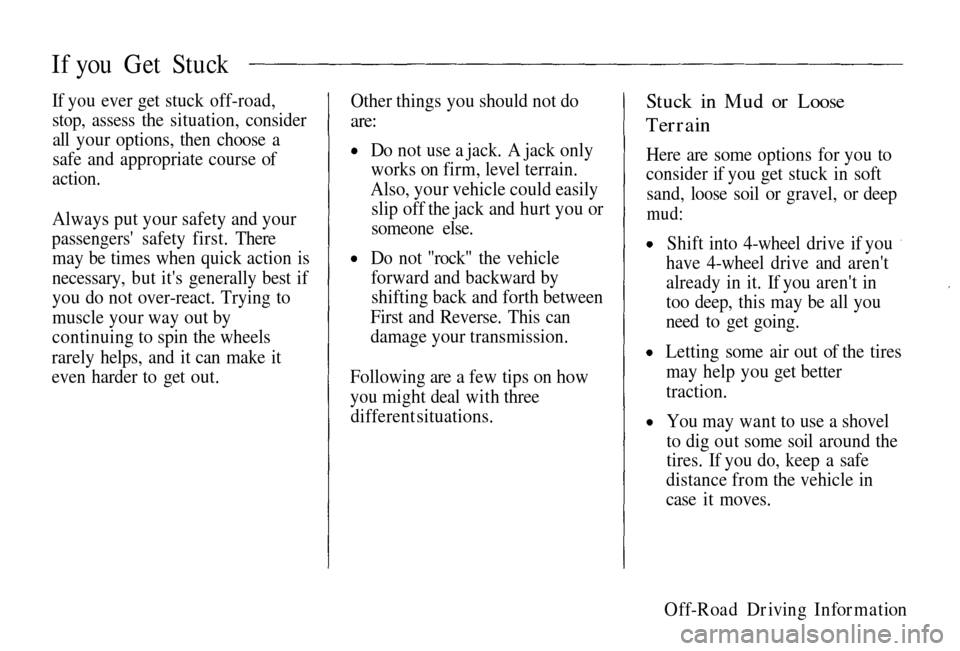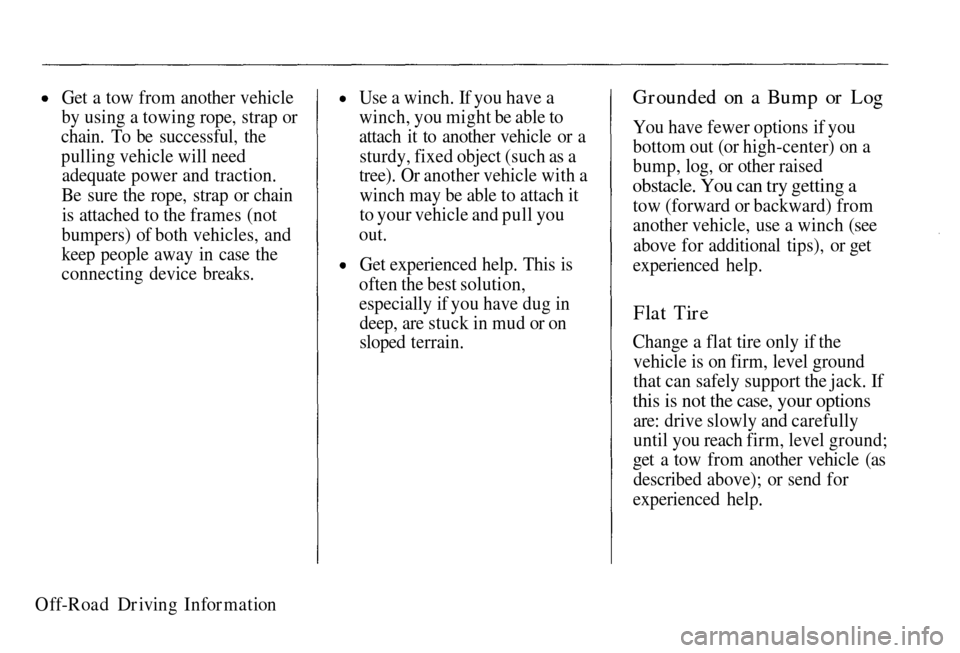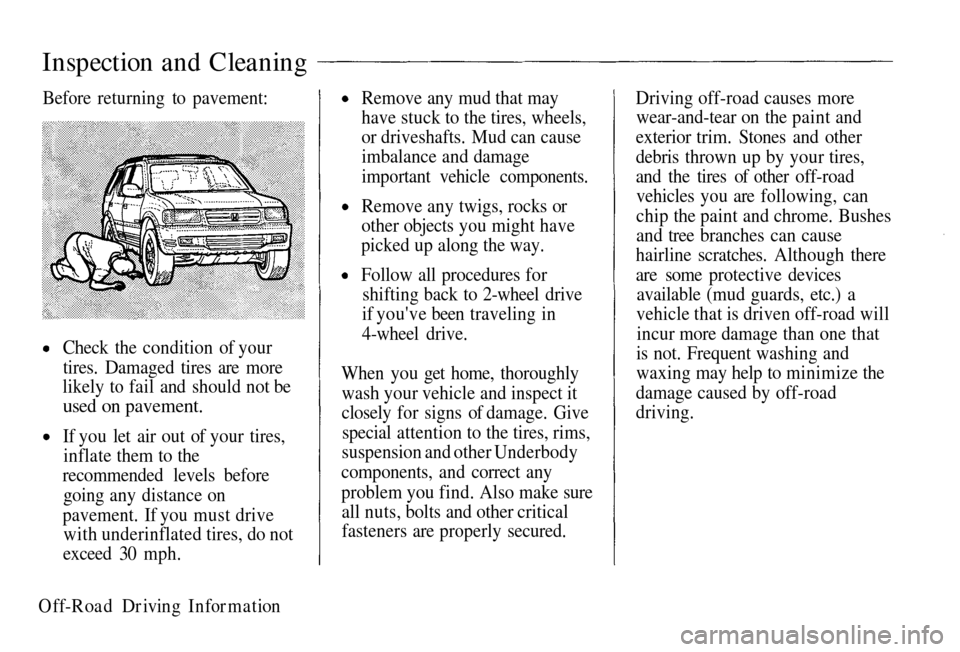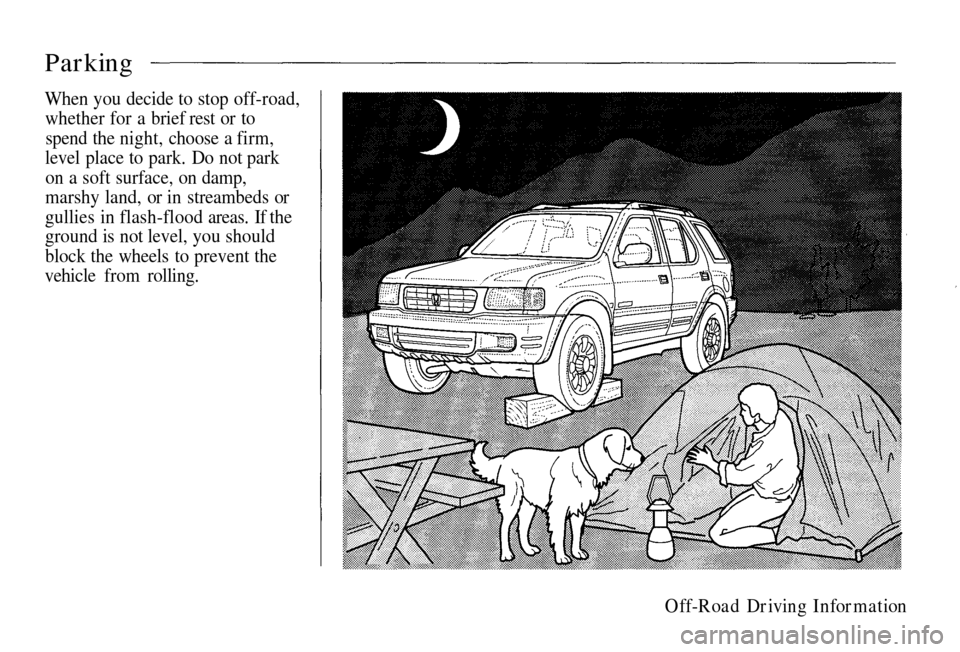HONDA PASSPORT 2002 2.G Owners Manual
PASSPORT 2002 2.G
HONDA
HONDA
https://www.carmanualsonline.info/img/13/5997/w960_5997-0.png
HONDA PASSPORT 2002 2.G Owners Manual
Trending: height adjustment, oil filter, ECU, park assist, change key battery, tire size, sensor
Page 291 of 294

If you Get Stuck
If you ever get stuck off-road, stop,
assess the situation, consider
all
your options, then choose a
safe and appropriate course of
action.
Alway
s put your safety and your
passengers' safety first. There may be times when quick action is
necessary,
but it's generally best if
you do not over-react. Trying to
muscle
your way out by
continuing
to spin the wheels
rarely helps, and it can make it
even
harder to get out. Other
things you should not do
are:
Do not use a jack. A jack only
works
on firm, level terrain.
Also, your vehicle could easily slip off the jack and hurt you or
someone
else.
Do not "rock" the vehicle
forward
and backward by
shifting back and forth between
First
and Reverse. This can
damage your transmission.
Following are a few tips on how
you
might deal with three
different
situations. Stuck in Mud or Loose
Terrain
Here are some options for you to
consider if you get stuck in softsand,
loose soil or gravel, or deep
mud:
Shift into 4-wheel drive if you
have 4-wheel drive and aren't
already in it. If you aren't in
too
deep, this may be all you
need
to get going.
Letting some air out of the tires may help you get better
traction.
Yo
u may want to use a shovel
to dig out some soil around the
tires.
If you do, keep a safe
distance from the vehicle in
case
it moves. Off-Road Driving Information
Page 292 of 294

Get a tow from another vehicle
by using a towing rope, strap or
chain.
To be successful, the
pulling vehicle will need adequate
power and traction.
Be sure the rope, strap or chain is attached to the frames (not
bumpers
) of both vehicles, and
keep
people away in case the
connecting device breaks. Use a winch. If you have a
winch, you might be able to
attach it to another vehicle or a
sturdy, fixed object (such as a
tree).
Or another vehicle with a
winch may be able to attach it to your vehicle and pull you
out
.
Get experienced help. This is
often
the best solution,
especially if you have dug in deep, are stuck in mud or on
sloped terrain. Grounded
on a Bump or Log
You have fewer options if you bottom
out (or high-center) on a
bump,
log, or other raised
obstacle. You can try getting a
tow
(forward or backward) from
another vehicle, use a winch (see
above
for additional tips), or get
experienced help.
Flat Tire
Change a flat tire only if the vehicle
is on firm, level ground
that can safely support the jack. If
this is not the case, your options
are:
drive slowly and carefully
until you reach firm, level ground;
get a tow from another vehicle (as
described
above); or send for
experienced help. Off-Road Driving Information
Page 293 of 294
Parking
When you decide to stop off-road,
whether for a brief rest or to
spend the night, choose a firm,
level
place to park. Do not park
on a soft surface, on damp,
marshy
land, or in streambeds or
gullies in flash-flood areas. If the
ground
is not level, you should
block the wheels to prevent the
vehicle
from rolling. Off-Road Driving Information
Page 294 of 294

Inspection and Cleaning
Check the condition of your
tires. Damaged tires are more
likely to fail and should not be
used on pavement.
If you let air out of your tires,inflate them to the
recommended
levels before
going
any distance on
pavement.
If you must drive
wit
h underinflated tires, do not
exceed
30 mph. Remove
any mud that may
have
stuck to the tires, wheels,
or driveshafts. Mud can cause
imbalance
and damage
important vehicle components.
Remove any twigs, rocks or
other objects you might have
picked up along the way.
Follow
all procedures for
shifting back to 2-wheel drive
if you've been traveling in
4-wheel
drive.
When you get home, thoroughly wash your vehicle and inspect it
closely
for signs of damage. Give
special attention to the tires, rims,
suspension and other Underbody
components, and correct any
problem you find. Also make sure all
nuts, bolts and other critical
fasteners
are properly secured. Driving off-road causes more
wear-and-tear
on the paint and
exterior trim. Stones and other debris
thrown up by your tires,
and
the tires of other off-road
vehicles you are following, can
chip
the paint and chrome. Bushes
and tree branches can cause
hairline
scratches. Although there
are some protective devices available
(mud guards, etc.) a
vehicle that is driven off-road will
incur
more damage than one that
is not. Frequent washing and
waxing may help to minimize the
damage caused by off-road
driving.
Befor
e returning to pavement:
Off-Road Driving Information
Trending: fog light, remove seats, spark plugs replace, ECU, dimensions, four wheel drive, washer fluid







